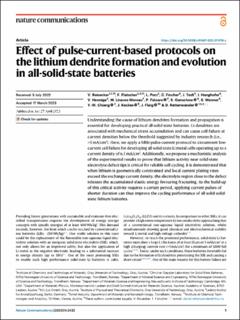| dc.contributor.author | Reisecker, V. | |
| dc.contributor.author | Flatscher, Florian | |
| dc.contributor.author | Porz, Lukas | |
| dc.contributor.author | Fincher, C. | |
| dc.contributor.author | Todt, J. | |
| dc.contributor.author | Hanghofer, I. | |
| dc.contributor.author | Hennige, V. | |
| dc.contributor.author | Linares-Moreau, M. | |
| dc.contributor.author | Falcaro, P. | |
| dc.contributor.author | Ganschow, S. | |
| dc.contributor.author | Wenner, Sigurd | |
| dc.contributor.author | Chiang, Y.-M. | |
| dc.contributor.author | Keckes, J. | |
| dc.contributor.author | Fleig, J. | |
| dc.contributor.author | Rettenwander, Daniel | |
| dc.date.accessioned | 2023-11-30T12:29:30Z | |
| dc.date.available | 2023-11-30T12:29:30Z | |
| dc.date.created | 2023-05-30T12:53:43Z | |
| dc.date.issued | 2023 | |
| dc.identifier.citation | Nature Communications. 2023, 14 (1), . | en_US |
| dc.identifier.issn | 2041-1723 | |
| dc.identifier.uri | https://hdl.handle.net/11250/3105421 | |
| dc.description.abstract | Understanding the cause of lithium dendrites formation and propagation is essential for developing practical all-solid-state batteries. Li dendrites are associated with mechanical stress accumulation and can cause cell failure at current densities below the threshold suggested by industry research (i.e., >5 mA/cm2). Here, we apply a MHz-pulse-current protocol to circumvent low-current cell failure for developing all-solid-state Li metal cells operating up to a current density of 6.5 mA/cm2. Additionally, we propose a mechanistic analysis of the experimental results to prove that lithium activity near solid-state electrolyte defect tips is critical for reliable cell cycling. It is demonstrated that when lithium is geometrically constrained and local current plating rates exceed the exchange current density, the electrolyte region close to the defect releases the accumulated elastic energy favouring fracturing. As the build-up of this critical activity requires a certain period, applying current pulses of shorter duration can thus improve the cycling performance of all-solid-solid-state lithium batteries. | en_US |
| dc.language.iso | eng | en_US |
| dc.publisher | Springer Nature | en_US |
| dc.rights | Navngivelse 4.0 Internasjonal | * |
| dc.rights.uri | http://creativecommons.org/licenses/by/4.0/deed.no | * |
| dc.title | Effect of pulse-current-based protocols on the lithium dendrite formation and evolution in all-solid-state batteries | en_US |
| dc.title.alternative | Effect of pulse-current-based protocols on the lithium dendrite formation and evolution in all-solid-state batteries | en_US |
| dc.type | Journal article | en_US |
| dc.type | Peer reviewed | en_US |
| dc.description.version | publishedVersion | en_US |
| dc.rights.holder | This article is licensed under a Creative Commons Attribution 4.0 International License, which permits use, sharing, adaptation, distribution and reproduction in any medium or format, as long as you give appropriate credit to the original author(s) and the source, provide a link to the Creative Commons license, and indicate if changes were made. The images or other third party material in this article are included in the article’s Creative Commons license, unless indicated otherwise in a credit line to the material. If material is not included in the article’s Creative Commons license and your intended use is not permitted by statutory regulation or exceeds the permitted use, you will need to obtain permission directly from the copyright holder. To view a copy of this license, visit http://creativecommons.org/licenses/by/4.0/. | en_US |
| dc.source.pagenumber | 0 | en_US |
| dc.source.volume | 14 | en_US |
| dc.source.journal | Nature Communications | en_US |
| dc.source.issue | 1 | en_US |
| dc.identifier.doi | 10.1038/s41467-023-37476-y | |
| dc.identifier.cristin | 2150168 | |
| cristin.ispublished | true | |
| cristin.fulltext | original | |
| cristin.qualitycode | 2 | |

